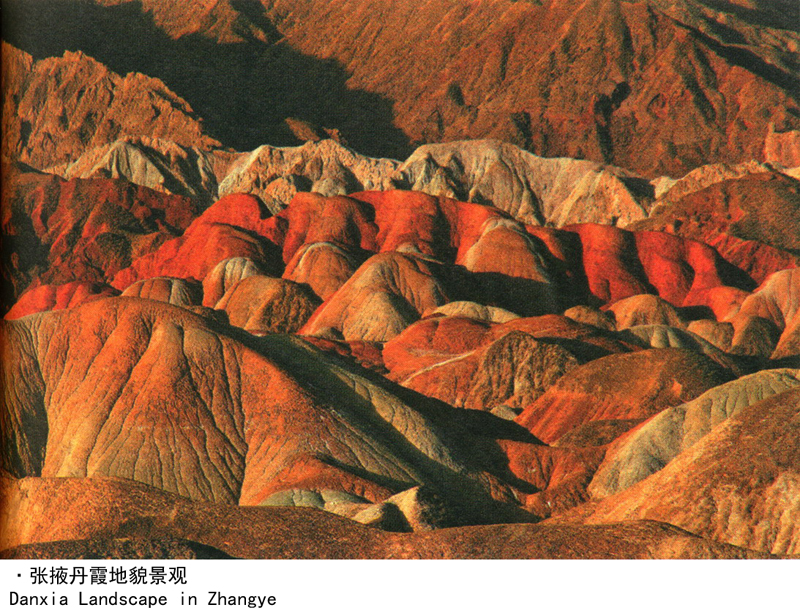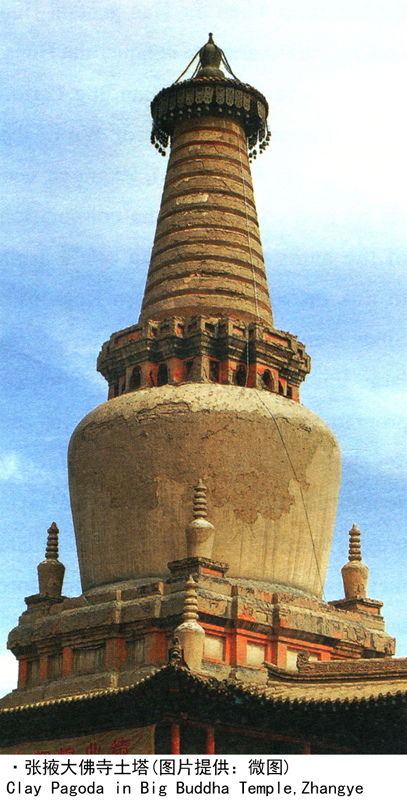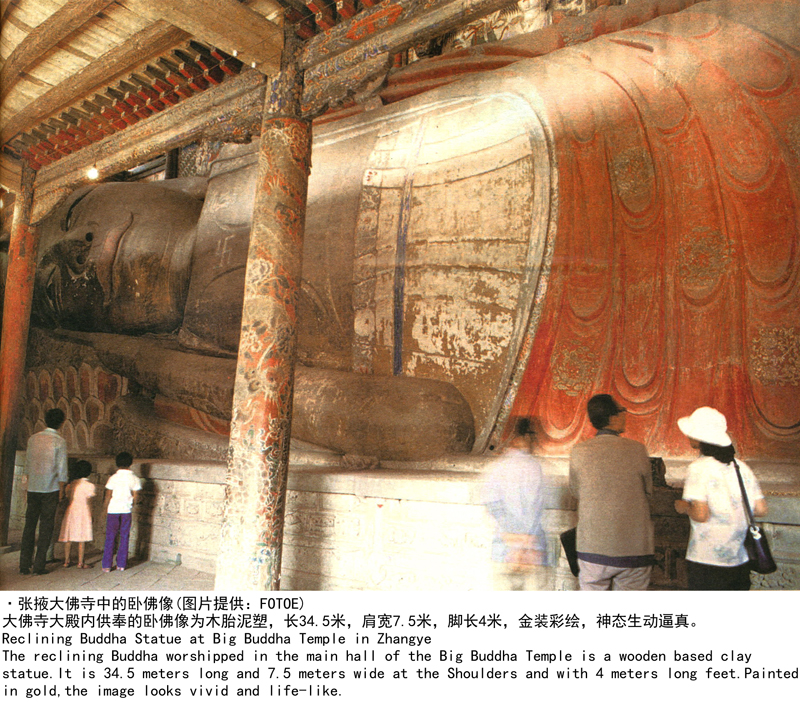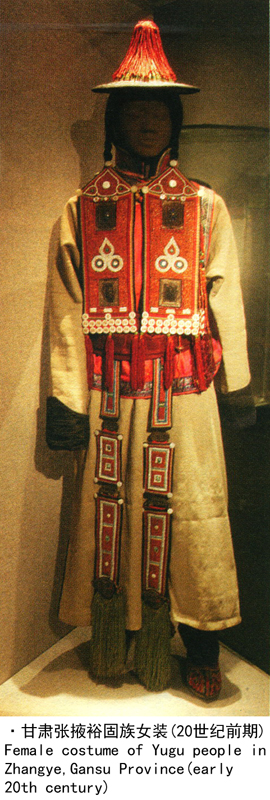丝路概说
- 交通路线
- 长安与丝绸之路
- 从长安到罗马——汉唐丝路全程探行纪实上
- 从长安到罗马——汉唐丝路全程探行纪实下
- 海上丝路史话
- 丝绸之路史研究
- 早期丝绸之路探微
- 早期丝绸之路文献研究
- 中西丝路文化史
- 沧桑大美丝绸之路
- 传播友谊的丝绸之路
- 路途漫漫丝貂情——明清东北亚丝绸之路研究
- 世界的中国——丝绸之路
- 丝绸之路
- 丝绸之路寻找失落的世界遗产
- 丝绸之路2000年
- 丝绸之路——从西安至帕米尔
- 丝绸之路经济带发展报告2014
- 丝绸之路考古十五讲
- 丝绸之路——神秘古国
- 丝绸之路——沿线城镇的兴衰
- 丝绸之路在中国
- 丝路景观
- 丝路起点长安
- 丝路文化新聚焦
- 丝路之光——创新思维与科技创新实践
- 中国丝绸之路交通史
- 中华文明史话-敦煌史话
- 中国·北海合浦海上丝绸之路始发港理论研讨会论文集
- 丝绸之路
- 丝绸之路新史
- 西域考古文存
- 丝绸之路的起源
▲张掖
作者:方明




张掖位于甘肃省的西北部,河西走廊中段,古称“甘州”。这里南枕祁连山,北依合黎山、龙首山,黑河从中贯穿而过,形成了特有的荒漠绿洲景象。张掖境内地势平坦、土地肥沃、林茂粮丰、瓜果飘香,雪山、草原、沙漠相映成趣,既有南国风韵,又具塞上风情,有人写诗赞美道“不望祁连山顶雪,错将甘州当江南”。与同处河西走廊的许多城市一样,张掖也诞生于霍去病率领汉军征讨河西匈奴之时。汉武帝元鼎六年(前121),西汉王朝置张掖郡,取“张国臂掖,以通西域”之意。此后,朝廷开始在张掖进行大规模的移民垦殖活动,戍兵屯田,发展农业,促进了中原与西域之间的经济、文化交流。张掖遂成为丝绸之路上的重镇。
魏晋时期,匈奴军事统帅沮渠蒙逊在张掖建立了北凉国。他大力发展农业,支持儒学,扩大同西域各国的交流,推广佛教,开凿石窟,并以当地音乐、歌舞与龟兹乐相结合,创造出新的音乐《秦汉伎》,一时间张掖呈现出文化空前繁荣的局面。西魏时,张掖改为“甘州”。隋唐时期,随着丝绸之路的繁荣,张掖进一步成为对外贸易的重要场所。高僧玄奘去天竺取经就曾途经张掖。王维、高适、岑参、马云奇等文人都曾驻足甘州,留下传世诗篇。甘州音乐《波罗门佛曲》传入宫廷后,经唐玄宗改制为著名的《霓裳羽衣舞曲》。北宋时期,党项族首领李元昊建立西夏国后,在甘州建成了规模宏大的佛教寺院——大佛寺。寺内安放的释迦牟尼涅槃像,为世界上最大的木胎泥塑、金装彩绘卧佛。
元时置甘肃行省,甘州成为河西走廊的驿道中枢和茶叶外贸的转口城市,商路四通八达,商品交易频繁。意大利旅行家马可·波罗前往上都的途中,曾在甘州停留一年,《马可·波罗游记》中就记述了这个城市的富庶及城中寺庙的宏伟。
明清时期,甘州仍然是西北方的军事补给基地,河西地区的政治、军事和经济中心。它不仅商业持续繁荣,而且成为西北最大的畜产品集散市场,全国各地商人云集于此,贸易活动辐射到新疆、蒙古等西北广大地区。
>Zhangye
Located in northwestern Gansu and in the middle section of the Hexi Corridor,Zhangye was called Ganzhou in ancient times.Lying on the Qilian Mountain to the south,the Heli and Longshou Mountain in the north and the Black River flowing through,all these geographical features contribute to Zhangye's unique landscape of desert oasis.Zhangye is endowed with flat terrain,fertile soil,luxuriant forests and crops,fragrant fruits and melons.The snow-capped mountains,the grasslands,and the deserts coexist side by side,featuring sceneries both in southern China and in northern frontier.As praised by some poet:〝If one does not see the snow-capped Qilian Mountain,one may think that Ganzhou is in southern China."Same as many other cities in the Hexi Corridor,Zhangye was also born against the backdrop when the Han general Huo Qubing led the army to conquer the Huns.In the 6th year of the Yuanding Period during the reign of Emperor Wu of the Han Dynasty(121 B.C.),Zhangye was set up as a county and the connotation of the name means〝open one's arms to link up with the Western Regions".Since then,the imperial court initiated a large immigration and land reclamation program in Zhangye,stationed troops and developed agriculture.This has further promoted the economic and cultural prosperity of both the Central Plains and the Western Regions.Zhangye therefore became an important city on the Silk Road.
During the Wei and the Jin periods,Juqu Mengxun,military commander of the Huns,established the Northern Liang Kingdom and designated Zhangye the capital.He put a great deal of effort in agricultural development.He supported Confucianism and expanded exchanges with western region countries.He promoted Buddhism and authorized to build grottoes.Moreover,he created Qinhanji,a new type of musical performance by combining local music and dance with ancient Qiuci music.Zhangye hence emerged unprecedented prosperity in cultural development.During the Western Wei Period,Zhangye was renamed Ganzhou.With the prosperity of the Silk Road during the Sui and the Tang dynasties,Zhangye further became an important external trade center.The eminent monk Xuanzang once visited Zhangye on his way west to Tianzhu for Buddhism scriptures.A few poets in Chinese history like Wang Wei,Gao Shi,Cen Shen and Ma Yunqi had all stayed in Ganzhou invariably where they left fine literature works behind.The well-known music piece Colorful Plumage Dance(Ni Shang Yu Yi Wu)adapted by Emperor Xuanzong of the Tang Dynasty based on the Ganzhou local music Brahman Buddhist Songs after it was introduced to the imperial palace.During the Northern Song Dynasty,Li Yuanhao,head of the Dangxiang ethnic people,established the Western Xia Kingdom.He authorized to build a large Buddhist monastery in Ganzhou named Big Buddha Temple.The Sakyamuni Nirvana statue placed in the temple is the largest in the world.The Reclining Buddha has a wooden base and clay cover painted in gold.
After Gansu Province was established during the Yuan Dynasty,Ganzhou became a vital hub in the Hexi Corridor and a city of transit trade for tea.The commercial network was quite advanced and the trade was busy.The Italian traveler Marco Polo on his way to Shangdu stopped over in Ganzhou for a year.In The Travels of Marco Polo,he described the city's prosperity and its magnificent temples.
During the Ming and the Qing dynasties,Ganzhou was the military supply base in the northwest and the political,military and economic center of the Hexi region.The city not only enjoyed continued commercial prosperity,but also became the largest distribution center for livestock products in the northwest.The Merchants from nationwide gathered here and trade radiated to other broad areas of Xinjiang and Mongolia in northwest China.
西域民族——裕固族
裕固族是聚居在甘肃省河西走廊肃南地区的少数民族,起源于唐代游牧在鄂尔浑河流域的回鹘人。9世纪中叶,回鹘人的一支迁至甘肃河西走廊一带,史称“河西回鹘”。明初,河西回鹘又陆续迁至祁连山一带,逐渐形成了裕固族。裕固族人使用三种语言,即阿尔泰语系突厥语族的尧乎尔语、阿尔泰语系蒙古语族的恩格尔语和汉语。裕固族无本民族文字,一般通用汉文。裕固族是以畜牧业为主的民族,传统居住方式是住毛毡帐篷,穿的衣服鞋袜和吃的肉奶都是畜产品,而且大部分生产和生活用具也都是由毛皮制成。在宗教信仰方面,裕固族主要信奉藏传佛教格鲁派(黄教)。
Yugu,an ethnic people in the Western Regions
Yugu is an ethnic minority people inhabited in the southern area of the Hexi Corridor in Gansu Province.They are descendents of the monadic Uighurs who roamed around the Orkhon Valley during the Tang Dynasty.In mid-9th century,one branch of the Uighurs moved to the Hexi Corridor in Gansu,known as the〝Hexi Uighurs"in history.In the early Ming Dynasty,the Hexi Uighurs gradually moved to the Qilian Mountain area and formed the Yugu ethnic group.Three languages were spoken by the Yugus,namely Yoghur of Turkic branch of the Altaic languages,Engel of the Mongolian branch of the Altaic languages and Chinese.Yugus have no written language.They use Chinese.Yugus engaged mainly in livestock production.Historically,they lived in felt tents,wore clothes and footwear made of animal skins and animal hair,and ate animal meat and milk.Most of their production tools and daily use articles were made of leather and fur.In terms of religious beliefs,the Yugus were mainly affiliated to the Gelug Sect of the Tibetan Buddhism(Yellow Sect).
丝绸之路/方明编著.-合肥: 黄山书社, 2013;